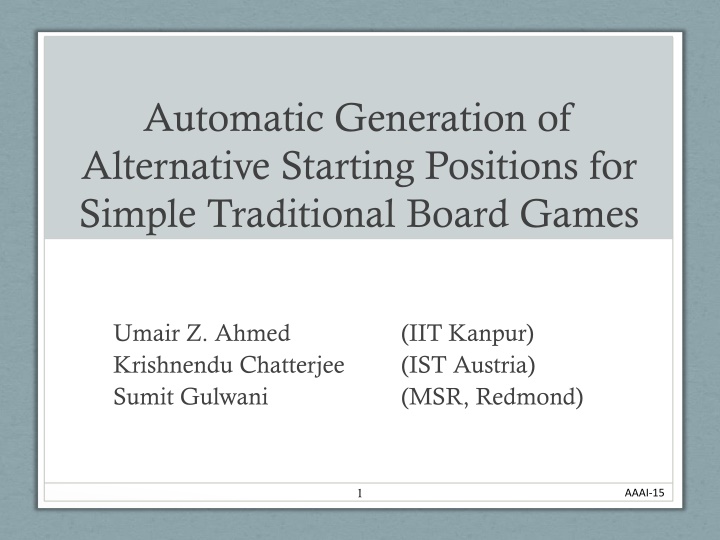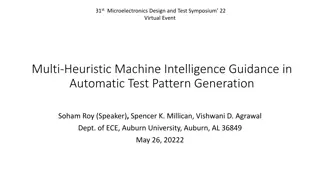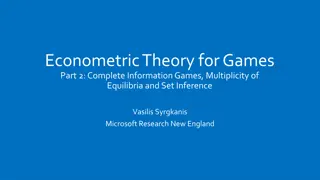Automatic Generation of Alternative Starting Positions for Board Games
This research focuses on automatically generating alternative starting positions for traditional board games like Tic-Tac-Toe and Connect-4. It introduces a novel problem of customizing the hardness level of the starting state to enhance player experience. The approach involves generating multiple fresh start states to prevent strategies from being memorized and customizing the length of play to avoid boredom. The study presents theoretical and experimental results, proposing search strategies applicable to all graph games.
Download Presentation

Please find below an Image/Link to download the presentation.
The content on the website is provided AS IS for your information and personal use only. It may not be sold, licensed, or shared on other websites without obtaining consent from the author.If you encounter any issues during the download, it is possible that the publisher has removed the file from their server.
You are allowed to download the files provided on this website for personal or commercial use, subject to the condition that they are used lawfully. All files are the property of their respective owners.
The content on the website is provided AS IS for your information and personal use only. It may not be sold, licensed, or shared on other websites without obtaining consent from the author.
E N D
Presentation Transcript
Automatic Generation of Alternative Starting Positions for Simple Traditional Board Games Umair Z. Ahmed Krishnendu Chatterjee Sumit Gulwani (IIT Kanpur) (IST Austria) (MSR, Redmond) 1 AAAI-15
Simple Traditional Board Games Board games such as Tic-Tac-Toe and Connect-4 Default start state is the empty board The traditional research question: who is the winner and optimal strategies from the empty starting state 2 AAAI-15
Novel Problem: Alternative Starting Positions Customizing hardness level of starting state Default start state can be biased (Tic-Tac-Toe 4x4) Even if unbiased not conducive for novice players Generating multiple fresh start states Strategies can be memorized Customizing length of play Long plays can be boring. 3 AAAI-15
Alternative Starting Positions Automatically generate interesting starting states \ Our results: Theoretical : A search strategy that applies to all graph games. Experimental: For simple board games Source: www.shredderchess.com 4 AAAI-15
Alternating Graph Game ? = G finite graph V vertex set ?1 player-1 vertices, partition of V ?2 player-2 vertices, partition of V E edge set, ? ?,? , ?1,?2 ?1 ?2 ?2 ?1 ?1- winning/target set for player-1, ?1 ? ?2- winning/target set for player-2, ?2 ? 5 AAAI-15
Our Approach First, compute ??from where player 1 can ensure to win in atleast j-steps. For positions in ??, determine the hardness of positions using min-max evaluation. 6 AAAI-15
Two Issues Game graphs are large: Computing ?? is computational expensive. For large depth strategies evaluation using min-max strategies is also computationally expensive. 7 AAAI-15
Solution Ideas 1. Symbolic Methods: Represent game symbolically using variables and compute ?? (details in paper) symbolically 2. Iterative Simulation: Determine hardness using lightweight small-depth strategies (details in paper). 8 AAAI-15
Board Games Variants O X X X O O O Connect-4 O X X O O O X X O X X O X O X O O X O X O X X X O Tic-Tac-Toe Bottom-2 Variable parameters 1. Board Size: 3x3, 4x4, 4x5, 2. Winning Condition: RCD, RC, CD, RD 3. Gravity: None, Partial, Full 9 AAAI-15
Experimental Results Connect-4 5x5 with 5000 Random Sampling, against k2 = 3 k1 = 1 k1 = 2 k1 = 3 State Space Win Cond # States |Wj| j E * * * * * * * * M 184 81 106 364 445 328 398 146 H 215 239 285 173 832 969 1206 73 E * * * * * * * * M 141 129 70 151 209 397 506 340 508 464 538 171 110 H E * * * * * * * * M 0 0 0 0 208 211 111 208 179 111 120 H 6.9x107 8.7x107 1.0x108 9.5x107 6.9x107 8.7x107 1.0x108 9.5x107 RCD 1.2x106 RC 1.6x106 RD 1.1x106 CD 5.3x105 RCD 2.8x105 RC 7.7x105 RD 8.0x105 CD 1.5x105 0 0 0 0 186 82 96 2 3 72 10 AAAI-15
Experimental Results Existence of vertices of different hardness levels Player-1 depth k1 = 2 Game Size k1 = 1 k1 = 3 Tic-Tac-Toe Tic-Tac-Toe Bottom-2 Bottom-2 CONNECT-3 CONNECT-4 3x3 4x4 3x3 4x4 4x4 5x5 Only RCD Only RD Except RCD 11 AAAI-15
Experimental Results Existence of vertices of different hardness levels Number of interesting vertices are rare negligible fraction of huge state space Interesting games now possible in games with heavily biased starting states, like Tic-Tac-Toe 4x4 12 AAAI-15
Auto Generated Starting States Positions Player-1 (X) can win in j = 2 turns, which are difficult against k2 = 3 O X X X O O O Connect-4 RCD, k1=1,2 O X X O O O X X O X X O X O X O O X O X O X X X O Tic-Tac-Toe RC, k1=1 Bottom-2 RCD, k1=1,2 13 AAAI-15
Conclusion Novel problem definition: automatic generation of interesting starting states Search technique: Utilizing symbolic methods and iterative simulation Present results for simple traditional board games Future work: Whether can be extended to more complicated games 14 AAAI-15
Acknowledgment AAAI-15 travel partially supported by AAAI-2015 student scholarship Microsoft Research India travel grant Indian Institute of Technology (IIT) Kanpur Contact email: umair@iitk.ac.in 15 AAAI-15
Binary Decision Diagrams (BDD) ?(?1,?2, ?3) = ?1.?2.?3+ ?1.?2+ ?2.?3 Binary Decision Diagram Truth Table Source: Wikipedia 16 AAAI-15
BDD Operations EPre (Existential Predecessor) ? = ?1 (Winning states of Tic-Tac-Toe) ???? ? = {? ?; ? ?,(?,?) ?} O O X X O O X X X O O X X O O X X X O X X O O X X O O X X O O X X O X X O X O X O O O X O X X X X X O X O O O X O X X O 17 AAAI-15
BDD Operations APre (Universal Predecessor) ???? ? = {? ?; ?,? ?,? ?} ? = ????(?1) O X O X O O X X O O X X O X X O O X X X X O X O O X X O O O X O X X X O X O X X O X O O O X X X X O 18 AAAI-15
Search Strategy 1. Symbolic Methods: Represent game symbolically using variables and compute starting states using BDD operations 2. Iterative Simulation: Determine hardness (Easy, Medium or Hard) of the starting states, using Min- Max 19 AAAI-15
1. Symbolic Methods Obtain Target/Winning set ?1 Compute j-steps win set ?? ?0= ????(?1) ??+1 = ????(????(??)) 20 AAAI-15
2. Iterative Simulation: Min-Max 21 AAAI-15























